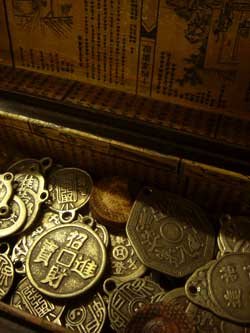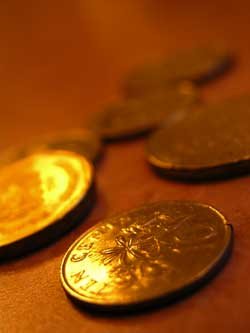|
Credit
 Credit is often loosely referred to as money. Money is used to buy goods and services, whereas credit buys goods and services on the promise to pay with money in the future. Credit is often loosely referred to as money. Money is used to buy goods and services, whereas credit buys goods and services on the promise to pay with money in the future.
This distinction between money and credit causes much confusion in discussions of monetary theory. In lay terms, and when convenient in academic discussion, credit and money are frequently used interchangeably. For example, bank deposits are generally included in summations of the national broad money supply. However, any detailed study of monetary theory needs to recognize the proper distinction between money and credit.
Bank notes are a form of credit. Gold-backed bills are likewise also a debt of the bank, a promise to pay in gold.
Federal Reserve notes, which are used as money in the United States, are difficult to describe in terms of credit, debt or money. Federal Reserve notes are not a promise to pay in gold, and the notes are irredeemable by the issuer. The Federal Reserve's notes are perhaps viewed best as a political promise to devalue (inflate) at a certain targeted rate.
 Since Federal Reserve notes are used in the United States as the most common medium of exchange, unit of account, and store of value, they are considered money by the majority of the population. To measure this kind of credit money, various forms of credit are counted together and listed as M1 or M2. M3 was the most common measure of monetary aggregates (or money supply), but the publication of M3 was discontinued by the RBA in March, 2006. Since Federal Reserve notes are used in the United States as the most common medium of exchange, unit of account, and store of value, they are considered money by the majority of the population. To measure this kind of credit money, various forms of credit are counted together and listed as M1 or M2. M3 was the most common measure of monetary aggregates (or money supply), but the publication of M3 was discontinued by the RBA in March, 2006.
Money
 Money is one of the most central topics studied in economics and forms its most cogent link to finance . Monetarism is an economic theory which Money is one of the most central topics studied in economics and forms its most cogent link to finance . Monetarism is an economic theory which
predominantly deals with the supply and demand for money. The stability of the demand for money prior to the 1980s was a key finding of the work of Milton Friedman , Anna Schwartz , David Laidler, and many others. Technical, institutional, and legal changes changed the nature of the demand for money during the 1980s.
Monetary policy aims to manage the money supply, inflation and interest to affect output and employment . Inflation is the decrease in the value of a specific currency over time and can be caused by dramatic increases in the money supply. The interest rate, the cost of borrowing money, is an important tool used to control inflation and economic growth in monetary economics. Central banks are often made responsible for monitoring and controlling the money supply, interest rates and banking .
A monetary crisis can have very significant economic effects, particularly if it leads to monetary failure and the adoption of a much less efficient barter economy. This happened in Russia, for instance, after the fall of the Soviet Union .
 There have been many historical arguments regarding the combination of money's functions, some arguing that they need more separation and that a single unit is insufficient to deal with them all. Financial capital is a more general and inclusive term for all liquid instruments, whether or not they are a uniformly recognized tender. There have been many historical arguments regarding the combination of money's functions, some arguing that they need more separation and that a single unit is insufficient to deal with them all. Financial capital is a more general and inclusive term for all liquid instruments, whether or not they are a uniformly recognized tender.
These are the major currencies used in trading.
Australia - Australian Dollar (AUD)
Canada - Canadian Dollar (CAD)
China - Renminbi (CNY)
European Monetary Union (EUR-12) - Euro (EUR)
Hong Kong - Hong Kong Dollar (HKD)
Japan - Japanese Yen (JPY)
Switzerland - Swiss Franc (CHF)
United Kingdom - Pound Sterling (GBP)
United States - US Dollar (USD)
Mexico – Mexican Peso (PMX)
Besides these currencies gold and silver are traded globally on the currency markets:
Gold (XAU) quoted in 1 ounce increments
Silver (XAG) quoted in 1000 ounce increments
Commodity
In the world of business , a commodity is an undifferentiated product , good or service that is traded based solely on its price, rather than quality and features. Examples include: electricity (most users of electric power are only concerned with energy consumption; only a minority of users are concerned with the quality and technical details of voltage and frequency deviations, phase imbalance, "stability" as guaranteed by backup equipment, etc.), wheat , bulk chemicals such as sulfuric acid , base and other metals, and even pork-bellies and orange juice. More modern commodities include bandwidth , RAM chips and (experimentally) computer processor cycles, and negative commodity units like emissions credits .
In the original and simplified sense, commodities were things of value, of uniform quality, that were produced in large quantities by many different producers; the items from each different producer are considered equivalent. It is the contract and this underlying standard that define the commodity, not any quality inherent in the product. One can reasonably say that food commodities, for example, are defined by the fact that they substitute for each other in recipes, and that one can use the food without having to look at it too closely.
|













